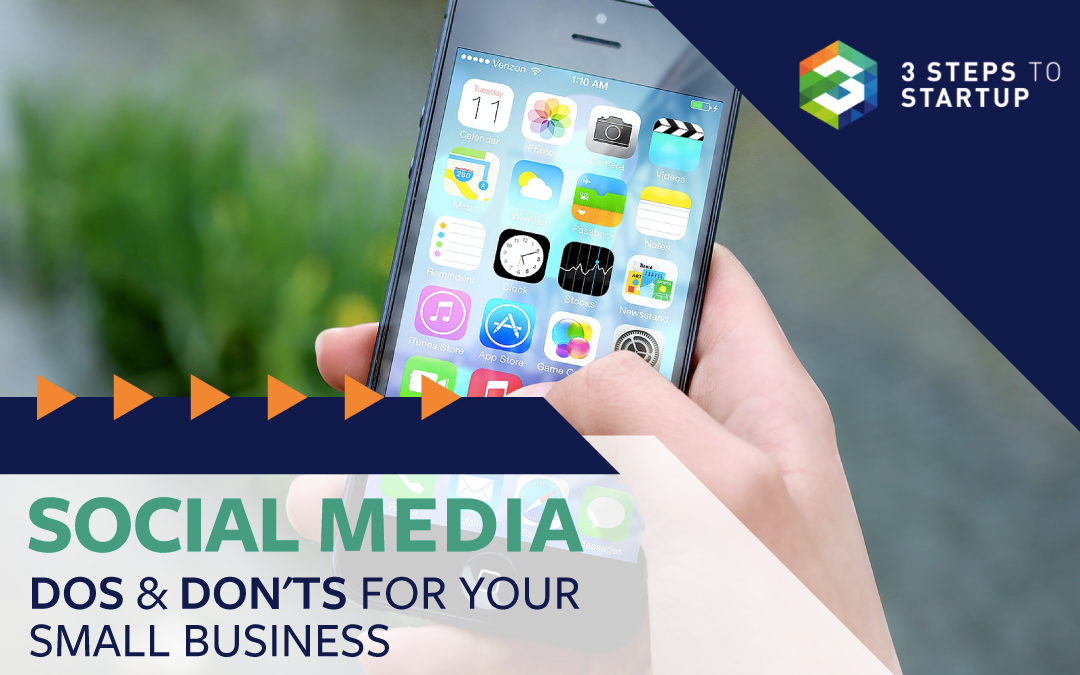
One of the ways we support West Virginia small businesses at 3 Steps to StartUp is by spreading useful knowledge. Our venture fairs and LIINC events last year brought innovators and entrepreneurs together to share their technical knowledge with aspiring small business owners. We also strive to provide information through our blog with posts like this one!
Social media cannot be ignored in today’s business world. With widespread social media use by consumers, a small business would be making a mistake to skip participating in social media. Business social media pages are a primary source of inbound marketing in today’s economy. 3 Steps to StartUp can connect you to any source of information you need to adequately run your small business, but today, we’re going to focus on some small business do’s and don’ts for social media.
Do:
Set goals for what you’d like to achieve with your social media presence. If you don’t set a goal, you will not ever achieve that goal! When you look at what your strategies are for social media pages, consider how much engagement you are looking for. The point of social media is exposure, and algorithms determine who sees your posts and how often. Your page’s engagement is what influences “the algorithm,” so set your goals with a strategy that enables you to reach them! Track which types of posts gain the most traction (engagement), and the sweet spot for post frequency and timing. Believe it or not, the day of the week or time of day can heavily influence the engagement of your post.
Don’t:
Neglect the tone of your posts. The tone of your posts should fit your brand. If you are selling sophisticated technical equipment to those with a technical background, it’s acceptable to use industry jargon to connect with your possible clients. If you’re in general retail, keep it more mainstream!
Also, consider the tone of your posts across platforms: don’t post-carbon copies of posts on different platforms. Remember, social media styles vary from platform to platform. Twitter is vastly different from TikTok and YouTube, which doesn’t necessarily translate to Facebook… you get the idea.
Do:
Try new strategies to increase engagement. Pick up on the trends you see around you – to do this, you need to spend a little time perusing other people’s content. Find concepts for posts that seem interesting to you and run with them! Look and see what works for others, and put your own spin on it. Engagement soars when you keep things fresh.
Don’t:
Expect that your social media accounts will “run themselves” as long as you schedule posts. Even if you post frequently throughout the day, an account run by an app that schedules posts can appear artificial. Humans do not engage as well with bots as they do real people. So, if you take a photo related to your business and it fits with your social media presence, post it! Also, consider saving your special and unique posts for times when they have time to shine.
Do:
Find the sweet spot for the number of posts you should be cycling through on a normal day. If you post too often, you run the risk of being unfollowed, decreasing overall engagement. On the other hand, if you don’t post enough, you remove yourself from a potential client or business connection’s feed.
Also, keep your posting consistent. Try your hardest to space your social media posts so you have enough content to continually post something. If your followers do not see you for a while, they might stop engaging for a while and you might get re-lost in the shuffle. On the other hand, do not be too aggressive. Too many posts can feel like spam.
Don’t:
Delete or argue with negative engagement. It might seem like it makes the most sense in the world to delete any negativity that comes to your social media pages. However, this strategy frequently backfires, when the commenter draws attention to the fact that you deleted their comment. They might insinuate that you are attempting to hide something.
Do:
Keep it positive. When you do engage with consumers on your business pages, be positive. On social media, consumers respond positively when you are positive, so stick to this rule and reap the benefits.
Don’t:
Use your personal page for business or vice versa. Your personal social media page should always be separate from your business social media page for you to maintain some semblance of privacy. Your business page is professional, but your page does not have to be.
Do:
Interact with other business social media pages! Tag other businesses and comment on their posts. Post a picture on Instagram and geo-tag another business to show support. Building relationships with other business owners may lead to a meaningful collaboration, which helps gain access to a new set of potential clients and followers. Plus, supporting other businesses creates goodwill and makes them likely to interact in return and support your business in the long term.
Finally, one last “Do”?
Have fun with it! At 3 Steps to StartUp, it is our joy to help small businesses adapt to put them in a position to succeed in West Virginia. Social media can be intimidating to navigate, but if you need any help or have any questions about social media, contact us! We would love to show you some tips and tricks!
Tags: 2022 Startups, 3 Steps To Startup, Business Networking, Business Start Up, Businesses, creative thinking, Educational Resource, generating ideas, Generating leads, Informational Blog, Rural Entrepreneurship, Small Town Businesses, successful entrepreneurship, West Virginia Small Business
